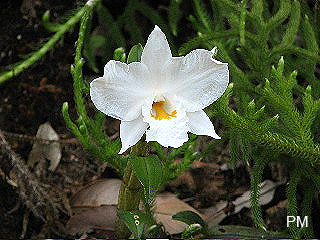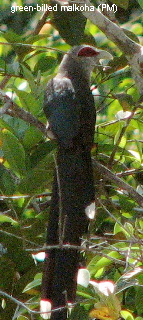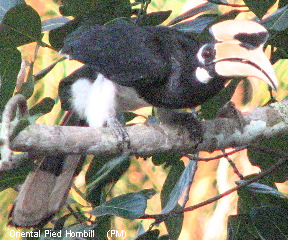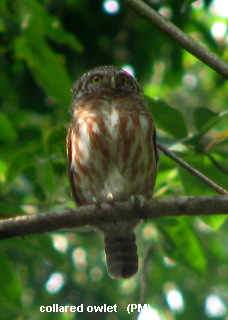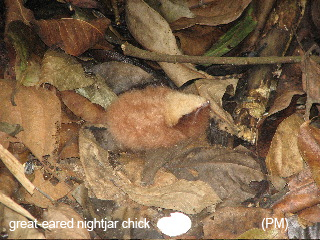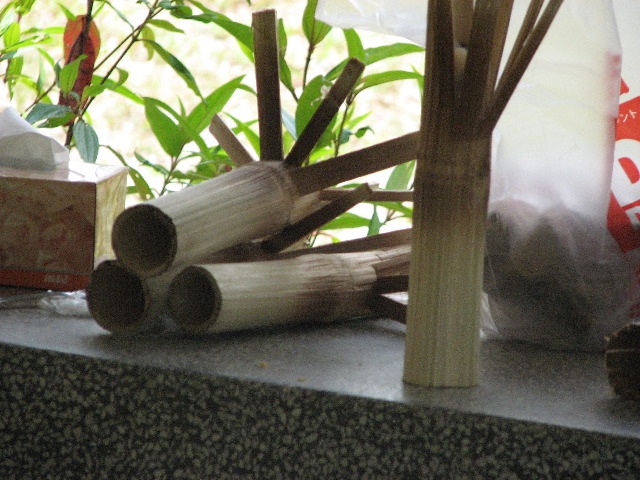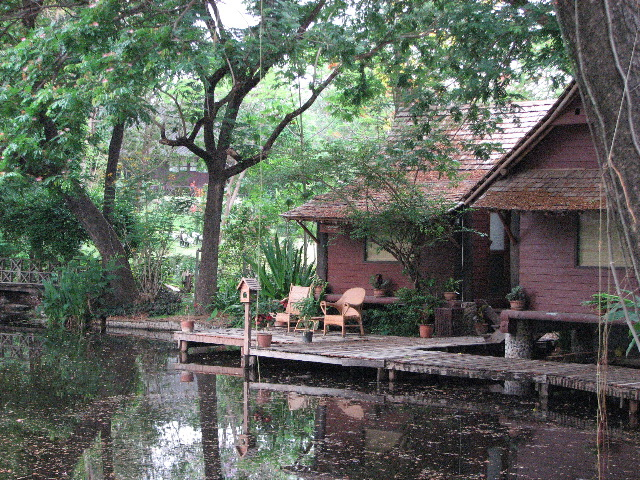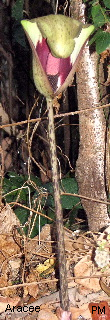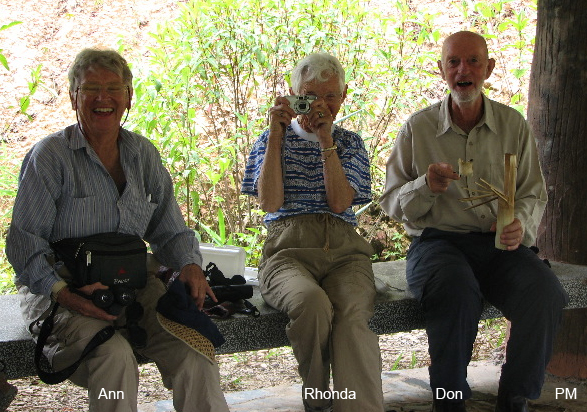Trip report
Birding Thailand
7 to 24 April 2007
From 7 to 24 April 2007, Trisha and I conducted our first birding tour to Thailand in conjunction with Uthai Treesucon, unquestionably Thailand’s best tour guide.
Areas birded
Primarily, we covered central and north Thailand. In the Bangkok area we birded Rangsit Marsh, around various Buddhist temples, Khao Yai National Park (NP) and Tap Lan NP. Southwest of Bangkok we birded assorted saltfields, prawn and fish farms and swamps and rice fields around Samut Sakhon, Samat Songhram, Phetchaburi and Kaeng Krachan NP.
In the Chiang Mai region of the north, we birded Doi Inthanon, Thailand’s highest mountain, as well as rice fields north of Chiang Mai. We also birded Doi Suthep, Chiang Dao, Doi Ang Klang, Doi Lang and the Thaton Marsh — now mostly cultivated; and various other government reserves north of Chiang Mai and a few swampy gravel pits to the west of Chiang Mai. Many of these areas, particularly the swamps, are down unmarked side roads that would be all but impossible to find on your own.Our tally was 412 bird species seen and another 29 heard.
Thanks go to Rosemary Bell, Mark Clayton, Mike Doyle, Ann Sutherland and Don and Rhonda Jennings for their contribution to a group of the most easygoing people a tour leader could hope for. Thanks also go to our drivers Taweep and Uthai II for conveying us safely in a land where transportation is often interesting, and for putting up with our shouts of STOP a lot more graciously than I do in Australia. Our gratitude and respect goes to Uthai Treesucon whose depth of ornithological knowledge and raw natural talent make him one of the shining stars of the birding world.
Day one
Uthai and his driver Taweep collected us at 6 am from our hotel in Bangkok and we headed to what remains of Rangsit Marsh on the north east edge of Bangkok.
Uthai was focussed on showing us some of the more difficult species such as black-browed reed-warbler, ruddy-breasted crake, yellow-bellied and plain priinias and yellow bittern; however, even the commonplace seemed exotic and we were happy to look at the more mundane species like streak-eared and yellow-vented bulbuls, Asian openbill stork, coppersmith barbet, red-rumped swallow, brown shrike and a black-capped kingfisher grappling with a large freshwater crayfish. The bird list took off rapidly with over 30 species recorded. It took Trish and me several days to see 30 species when we were birding on our own, although in our defence, we were in rainforest.
Next was a visit to a temple where a hum of Asian openbill storks were nesting — about 10,000 pairs. Also here was the first of many green-billed malkoha, a cuckoo with a very long tail.
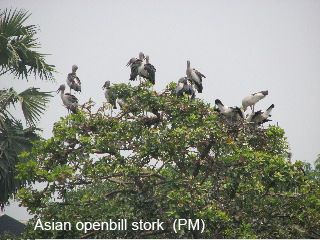
Moving on to another temple, Uthai quickly got us our first owl, the cute spotted owlet which, unlike our owls, seems to roost in quite open areas. Here we also added the stunning small minivet, and the first of many Indian rollers. Owlets are great in that they attract small birds that buzz them and this one managed to draw in common iora and flower-backed flowerpecker and the familiar olive-backed sunbird.
Then north to Wat Phra Bhudthabat Noi (Shrine of the Holy Footprint). Unseasonable rain delayed us for an hour but as it cleared birds set about preening. Golden-fronted leafbird and lineated barbet were added to our list and brief views of an uncooperative limestone wren-babbler.
In true Maher tradition we made it to our accommodation near Khao Yai NP just in time for dinner.
Day two
We birded the next morning along the roadside just past the entrance to the national park. A lot of species sun themselves and feed along the roadside verges when very little is happening inside the rainforest. Many of the common rainforest birds were seen such as black-crested bulbul (BCBs as Uthai likes to call them) and white-rumped shama, a great songster reminiscent of our superb lyrebird. We also had green-eared and moustached barbets and great looks at vernal hanging-parrot, one of the few parrots in Thailand; and our first blue-bearded rainbow bird.
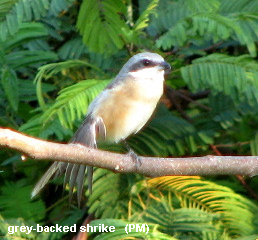
We had ventured further along the road in Khao Yai when a large grey and black bird with massive red bill flew across the road in front of us. A coral-billed ground-cuckoo, one of the must-see species in Khao Yai. Glimpsing its mate in the undergrowth, Uthai anticipated it would follow the other bird across the road and sure enough, after a couple of minutes, it undertook the crossing, giving us a full view. This was one of many highlights of the tour and so much better than seeing it scrounging kitchen scraps behind one of the park’s restaurants as Trisha and I had done prior to the tour starting, and I suspect most birders in Khao Yai NP do. Ground cuckoos differ from regular cuckoos in that they build their own nests and are non-parasitic.
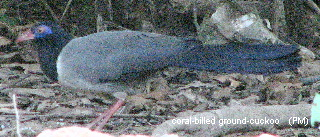
chinese goshawk
The tour coincided with a migration of raptors. We saw a battalion of 60 or so black baza in a swirling mass; nearby, three Chinese goshawk — distinctive with their black wingtips; a pair of crested serpent-eagles; and then a pair of Jerdon’s baza with characteristic patterned underwing.
We had three hornbills on our first day in Khao Yai NP, wreathed, oriental pied and great; and also greater flameback, the first of many brilliant woodpeckers. Other species alien to us included iroras, assorted bubuls, yuhinas, tit-babblers and spiderhunters, and the more familiar, drongos, sunbirds and flowerpeckers. Our last diurnal bird was the bizarre looking long-tailed broadbill.
After dinner, brown-hawk owl, not unlike our boobook, and a cute collared scops owl was observed near our hotel.
Day three
Some great birds were produced today including one of the highlights of the tour, the spectacular Siamese fireback (a type of pheasant) of which we saw no less than three males displaying along the roadside. And then just when we thought we couldn’t better that, we saw the very exotic looking red-headed and orange breasted trogans.
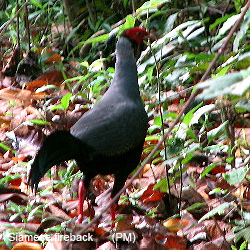
Next up was lesser-necklaced laughingthrush, lovely noisy birds that get about in groups but are rather shy. A pair of collared owlet flew in and mated in front of us.
After lunch, and a heavy shower of rain, we checked out a great-eared nightjar nest that Trisha and I had located in Khao Yai a couple of days before the tour. The nest, containing a single egg, was beside a secluded and little used path. Cautiously the group approached hoping to see the nightjar on the nest but it was too wary and took off. Looking at the nest, all we could see was a broken eggshell. Then Uthai spotted an incredibly well camouflaged chick in the leaf litter. We didn’t linger at the spot and the nightjar returned; our departure compelled not only for our concern for the chick but also by an attack of leeches active after the rain.
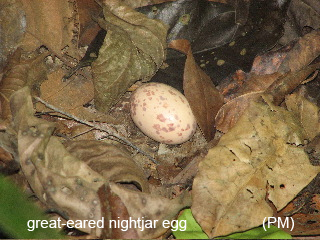
Birding in the Tiger Zone (few if any tigers are extant in Khao Yai NP) produced our first scimitar-babbler, the white browed. They are similar in shape to our babblers but are unrelated. Uthai’s expert eyes spotted a banded kingfisher, keeping deathly still and calling monotonously from the rainforest canopy.
Day four
We left the lush rainforest of Khao Ya NP behind this morning and headed for the dry dipterocarp forest of Tap Lan NP. The area is not unlike the savannah woodland around Darwin, and like our tropical woodland is burnt off annually.
Treepies are related to corvids and the rufous treepie we saw was disembowelling what appeared to be a fledgling woodpecker. Other birds included vinous-breasted myna and chestnut-tailed starling, blossom-headed parakeet, Indo-Chinese and large cuckoo-shrikes, brown prinia and some great looks at chestnut-bellied nuthatch, reminiscent of our own sittella, but in much smaller groups.
This was a good woodpecker day with grey-capped, common flameback, lesser yellownape and the stunning black-headed woodpecker. Personally satisfying were some hoopoe, one of the great birds of the world, and Eurasian jay, two species I’d been enthralled with since childhood. We also had crested treeswift and chestnut-capped babbler.
The yellow-footed green pigeon was a nice pickup by Mike, and added a write-in to the checklist.
We ate mangoes most days of the tour; mostly the exquisite nam-dok-mai variety. Today was the first day we ate mangoes with sticky rice encased in pieces of bamboo about a foot long. Sweet sticky rice and nam-dok-mai mangoes are a marriage made in heaven. Taweep pulled up at one of myriad roadside fresh food markets and Uthai would, in characteristic earnestness, choose our fruit for lunch. Mostly we had lunch at restaurants but the staff would prepare the mangoes or mangosteens and lychees that Uthai had bought.
Day five
At dawn we set off southwest of Bangkok. Our first stop was a salt field where men and women were pushing wheelbarrows loaded high with salt a hundred metres or so to a central pile. Tough going in hot and humid conditions.
Many of ‘our’ waders pass through Thailand on their way back to their breeding grounds in China and Siberia so there was a welcome element of familiarity. Broad-billed sandpipers were in quite good numbers and a few long-toed, little and red-necked stints were about.
There were many common redshanks and it was great to catch up with spotted redshank coming in to breeding plumage. Other new birds included Indian and little cormorants.
We visited another Buddhist temple where hundreds of Germain’s swiftlets were nesting inside the temple. Eight (shoeless) Australians with binoculars didn’t seem to worry anyone.
Lunching in a riverside restaurant we watched brown-headed gulls, and white-winged black terns in very smart plumage.
Fish ponds were our next stop where we had bronze-winged and pheasant-tailed jacanas. Also Asian golden weaver and Baya weaver; the latter had assembled a hanging nest that was stunning in design and structure. Other birds included Javan pond heron and red-wattled lapwing.
A pause at an ocean beach produced a pair of Malaysian plover, not so dissimilar to our red-capped plover. Our next stop was an experimental sewerage treatment works alive with birds. To us Australians, a flock of about 30 ruffs, which were approaching breeding plumage, was surprising.
Common snipe was seen here and more spotted and common redshanks as well as grey heron and a large water monitor.
Along with their orange breeding plumes, the cattle egrets at these ponds had mauve faces and yellow-tipped red bills. I’ve seen many cattle egrets in Australia in full breeding plumage but nothing as stunning as these.
Day six
We began our assailment of Thailand’s largest national park, Kaeng Krachan, on the mountain ranges near the Myanmar border, southwest of Bangkok. The terrain is steep and narrow with a few creek crossings and once inside the park, we abandoned our bus and transferred to a 4WD twin cab ute, the tray fitted out with bench seats. While a couple of our group would have fitted in the twin cab, none of us was going to miss out on the experience up the back of the ute. Uthai travelled in the front and instructed us to bang on the roof if we saw anything good. Dusky leaf monkeys had us soon dutifully thumping on the ute’s roof. It was suggested that we bang with less fervour. A few hundred metres further along collared owlet roosting on a bare limb over the road initiated another barrage of banging. Given that traffic can only travel one way in an allocated time span, Uthai was worried that we would never make it up the mountain if we didn’t curb our enthusiasm. We got the message. Further up the mountain we had some good birds including the vocal great barbet, the delightful white-browed piculet (a tiny woodpecker) and a lovely pair of large scimitar babbler.
Still further up, we had great looks at black-throated laughingthrush, grey treepie, little cuckoo-dove and mountain imperial pigeon. Unseasonable rain interrupted our birding for an hour or so — April is supposed to be the driest month! Post rain, the birding was good and we were thrilled to see pin-tailed parrot-finch feeding on seeding bamboo. Soon after we added racket-tailed treepie and yellow-eared spiderhunter. On the way back down we had more rain. Still no one would get in the twin cab. We were a pretty bedraggled lot by the time we got back to our bus. Travelling through the lower elevations we stopped for something and got another species of treepie, the ratchet-tailed — not to be confused with the racket-tailed.
Day seven
First up we birded some lowland habitats and got a lovely group of grey-rumped treeswift and a pair of yellow-eyed babblers (no relation to ours) and had a shikra (an accipiter) circling overhead. The lowlands also produced migrants such as tiger shrike and the drop-dead gorgeous yellow-rumped flycatcher. A Siberian blue robin called but didn’t show itself. Overhead we had more migrating raptors — a mixed flock of Chinese goshawk, Japanese sparrowhawk and crested goshawk. A bit further along the road we scored yet another woodpecker, the grey-headed.
At Park HQ we saw a black eagle soaring overhead, the only sighting for the tour. Beyond HQ, we had our only sighting of banded broadbill, which had a nearby nest. Most broadbills build large hanging nests, not unlike some of our scrub-wrens.
On the way down in the afternoon we got a pair of tiny black-thighed falconet at a nest cavity; and nearby, a pair of streak-breasted woodpecker.
Day eight
We were back to Kaeng Krachan NP at first light for what was, in every which way, a BIG bird day. First up a pair of great slaty woodpecker (the largest extant woodpecker in the world) flew in, had a bit of a squabble, and continued on their way, not to be seen again.
Nearby we had both rufous and grey-headed woodpeckers, and brief views of chestnut-winged cuckoo, more often heard than seen.
Green pigeons in green leafy trees are never easy to see but Uthai located, at one of the camping areas, a well-concealed yellow-vented pigeon.
Further up the mountain we got a pair of red-bearded bee-eaters as they worked on their nest hole in a roadside cutting. The next bird to capture our attention was the black and yellow broadbill. Then all of Uthai’s skill and experience came to the fore with the shy and secretive grey peacock-pheasant, another tour highlight.
Rain the previous day had prevented us looking for rusty-cheeked hornbill (formerly brown hornbill) so it was good to get two birds attending a nest hole today.
At the end of the road that goes up the mountain, we watched white-handed gibbons leaping through the treetops until our attention was diverted by a crimson sunbird fighting its reflection in the mirror of our ute. Both yellow-vented and scarlet-backed flowerpeckers were feeding in nearby trees.
Uthai’s expertise again came to the fore with the intricately marked skulker, spot-necked babbler.
Back at the national park campground where we had left our bus we had a nice congregation of small birds — greater green leafbird, little, spectacled and streaked spiderhunters, golden babbler, blue-throated barbet and grey-chinned minivet. White-crested laughingthrush, to me, one of the best birds in SE Asia, put in a brief appearance.
That night, I don’t think anyone was too concerned that torrential rain disrupted our spotlighting expedition; the birding today had been brilliant.
Day nine
Next morning, we birded the environs around the Kaeng Krachan national park headquarters. We had in the telescope a lovely Chinese goshawk perched in a tree and had our best look at a group of lesser- necklaced laughingthrush that had become a little less shy of people. We were joined by a Thai mother and her young son who looked about twelve years old — he already had over a hundred species on his list and apparently knew the field guide inside out. While not quite as youthful as our friend, we saw a lot of young birders in Thailand — most of them with top end gear.
Here we finally managed a good look at puff-throated babbler, which we had previously heard and glimpsed a lot.
Back to Bangkok for an afternoon flight to Chiang Mai in the north of Thailand. Our new driver, Uthai II, collected us along with his son, Uthai III. Three Uthais on board were quickly reduced to U1, U2 and U3. Heading southwest to Doi Inthanon, we stayed at the picturesque Doi Inthanon Highland Resort just outside the national park.
Part II
Checklist for the 2007 tour mammal list reptiles list
2010 itinerary
Doi Inthanon Highland Resort
